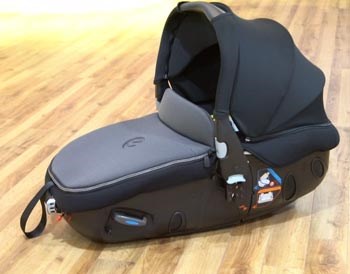Lie-flat Seats
A baby born weighing less than five and a half pounds, or 2499 grams, is known as a low birth weight baby.
Most newborn babies will use a rear-facing baby seat for the first 12-15 months, but if a child is low birth weight, it may be difficult to find a suitable seat that fits them. Even when using manufacturer inserts designed for newborn or premature babies, these seats may be too big to carry the infant safely.
In standard rear-facing car seats, a baby will sit at an angle of 40 to 45 degrees. In low birth weight babies, this may create breathing difficulties as the baby's head could fall forward and restrict their airway. In this instance, a lie-flat baby carrier might be a safer option. For more information, read our evidence review.

Lie-flat baby carriers have a strong shell and energy-absorbing interior. They have a 5-point harness to hold the baby in place, and in some cases may have removable inserts to keep the baby secure.
When the baby reaches 10kg, some models of lie-flat seat can be adjusted to a sitting position. This means that they can be used for a longer period of time, as they work in the same way as a standard rear-facing seat.
There are also a number of i-Size rear-facing seats with a lie-flat function available. However, when using one of these seats, it is vital to read the manufacturers instructions carefully because some of these features should not be used while the seat is in a vehicle.
To find out more about travelling with a low birth weight baby, view our video for parents and practitioners.
Fitting lie-flat seats
Although some i-Size seats with lie-flat functions are available, the majority of lie-flat carriers will conform to the R44 standard. Most are fitted in a similar way, but it is important to carefully read the manufacturer's instructions before fitting the seat.
Because of their size, most lie-flat carriers need to be positioned sideways across two of the vehicle's seats, meaning that it will need to be installed in the rear. The head part of the carrier should be positioned on the middle rear seat, as this is the furthest away from anything that could intrude into the vehicle during a collision. The safest place to place the foot end of the carrier is on the rear passenger seat, as most of the time you will be opening the door away from traffic.
To fit the carrier using seat belts, the bottom of the carrier should rest squarely on the vehicle seat and be stable. The manufacturers instructions will explain the fitting procedure.
Once fitted, it should be checked that the carrier is fitted securely. It should rest firmly in the vehicle seat with little forward movement.
Some lie-flat carriers can be fitted by clipping them into a separate isofix base. The isofix prongs on the base push into the anchorage points. Any support foot should always be used for extra stability. The manufacturers instructions should be followed to ensure that the base is fitted correctly.
The baby's feet should be touching the end of the carrier and the 5-point harness should not be twisted. To correctly adjust the harness, make sure that it is level or no more than 2cm below the baby's shoulders. The buckle should not be in contact with their stomach but rest in the pelvic area, and the harness should be pulled tight. There should be no toys or any other objects in the carrier.
View our video for more information on fitting a lie-flat carrier.
